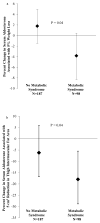Changes in serum aldosterone are associated with changes in obesity-related factors in normotensive overweight and obese young adults
- PMID: 23657296
- PMCID: PMC3766434
- DOI: 10.1038/hr.2013.45
Changes in serum aldosterone are associated with changes in obesity-related factors in normotensive overweight and obese young adults
Abstract
Recent data suggest excess circulating aldosterone promotes cardiometabolic decline. Weight loss may lower aldosterone levels, but little longitudinal data is available in normotensive adults. We aimed to determine whether, independent of changes in sodium excretion, reductions in serum aldosterone are associated with favorable changes in obesity-related factors in normotensive overweight/obese young adults. We studied 285 overweight/obese young adult participants (body mass index ≥ 25 and<40 kg m⁻², age 20-45 years) in a clinical trial examining the effects of a 1-year diet and physical activity intervention with or without sodium restriction on vascular health. Body weight, serum aldosterone, 24-h sodium and potassium excretion and obesity-related factors were measured at baseline, 6, 12 and 24 months. Weight loss was significant at 6 (7%), 12 (6%) and 24 months (4%; all P<0.0001). Decreases in aldosterone were associated with decreases in C-reactive protein, leptin, insulin, homeostasis assessment of insulin resistance, heart rate, tonic cardiac sympathovagal balance and increases in adiponectin (all P<0.05) in models adjusting for baseline age, sex, race, intervention arm, time since baseline, and sodium and potassium excretion. Weight loss and reductions in thigh intermuscular fat (intermuscular adipose tissue area; IMAT) were associated with decreases in aldosterone in the subgroup (n=98) with metabolic syndrome (MetS) at baseline (MetS × weight loss, P=0.04; MetS × change in IMAT, P=0.04). Favorable changes in obesity-related factors are associated with reductions in aldosterone in young adults with no risk factors besides excess weight, an important finding, given aldosterone's emergence as an important cardiometabolic risk factor.
Comment in
-
Changes in aldosterone and obesity-related cardiometabolic risk factors with a 1-year weight loss intervention in normotensive overweight and obese young adults.Hypertens Res. 2013 Oct;36(10):856-8. doi: 10.1038/hr.2013.77. Epub 2013 Jul 18. Hypertens Res. 2013. PMID: 23864057 No abstract available.
Similar articles
-
Serum aldosterone is associated with inflammation and aortic stiffness in normotensive overweight and obese young adults.Clin Exp Hypertens. 2012;34(1):63-70. doi: 10.3109/10641963.2011.618200. Epub 2011 Oct 18. Clin Exp Hypertens. 2012. PMID: 22007645 Free PMC article. Clinical Trial.
-
Short-term effects of a hypocaloric diet with low glycemic index and low glycemic load on body adiposity, metabolic variables, ghrelin, leptin, and pregnancy rate in overweight and obese infertile women: a randomized controlled trial.Am J Clin Nutr. 2015 Dec;102(6):1365-72. doi: 10.3945/ajcn.115.117200. Epub 2015 Nov 11. Am J Clin Nutr. 2015. PMID: 26561614 Clinical Trial.
-
Exercise improves adiposopathy, insulin sensitivity and metabolic syndrome severity independent of intensity.Exp Physiol. 2020 Apr;105(4):632-640. doi: 10.1113/EP088158. Epub 2020 Mar 16. Exp Physiol. 2020. PMID: 32020676
-
The effects of separate and combined dietary weight loss and exercise on fasting ghrelin concentrations in overweight and obese women: a randomized controlled trial.Clin Endocrinol (Oxf). 2015 Mar;82(3):369-76. doi: 10.1111/cen.12483. Epub 2014 Jun 12. Clin Endocrinol (Oxf). 2015. PMID: 24796864 Free PMC article. Clinical Trial.
-
Obesity, hypertension and aldosterone: is leptin the link?J Endocrinol. 2016 Jul;230(1):F7-F11. doi: 10.1530/JOE-16-0160. Epub 2016 Jun 1. J Endocrinol. 2016. PMID: 27252389 Free PMC article. Review.
Cited by
-
Rising Prevalence of Obesity and Primary Hyperaldosteronism: Co-incidence or Connected Circumstances Leading to Hypertension? A Narrative Review.J Gen Intern Med. 2025 Mar;40(4):871-878. doi: 10.1007/s11606-024-09081-2. Epub 2024 Oct 16. J Gen Intern Med. 2025. PMID: 39414738 Review.
-
Association of serum cortisol with insulin secretion and plasma aldosterone with insulin resistance in untreated type 2 diabetes: a cross-sectional study.Diabetol Metab Syndr. 2025 Apr 28;17(1):144. doi: 10.1186/s13098-025-01706-8. Diabetol Metab Syndr. 2025. PMID: 40296149 Free PMC article.
-
Autophagy in Adipocyte Browning: Emerging Drug Target for Intervention in Obesity.Front Physiol. 2019 Jan 28;10:22. doi: 10.3389/fphys.2019.00022. eCollection 2019. Front Physiol. 2019. PMID: 30745879 Free PMC article. Review.
-
Leptin links with plasminogen activator inhibitor-1 in human obesity: the SABPA study.Hypertens Res. 2015 Jul;38(7):507-12. doi: 10.1038/hr.2015.28. Epub 2015 Mar 5. Hypertens Res. 2015. PMID: 25740294
-
Effects of Hypocaloric Low-Fat, Ketogenic, and Ketogenic and Ketone Supplement Diets on Aldosterone and Renin.J Clin Endocrinol Metab. 2023 Jun 16;108(7):1727-1739. doi: 10.1210/clinem/dgad009. J Clin Endocrinol Metab. 2023. PMID: 36629058 Free PMC article. Clinical Trial.
References
-
- Nehme J, Mercier N, Labat C, Benetos A, Safar ME, Delcayre C, Lacolley P. Differences between cardiac and arterial fibrosis and stiffness in aldosterone-salt rats: effect of eplerenone. J Renin Angiotensin Aldosterone Syst. 2006;7:31–39. - PubMed
-
- Rossi GP, Belfiore A, Bernini G, Fabris B, Caridi G, Ferri C, Giacchetti G, Letizia C, Maccario M, Mannelli M, Palumbo G, Patalano A, Rizzoni D, Rossi E, Pessina AC, Mantero F. Body mass index predicts plasma aldosterone concentrations in overweight-obese primary hypertensive patients. J Clin Endocrinol Metab. 2008;93:2566–2571. - PubMed
-
- Goodfriend TL, Egan BM, Kelley DE. Plasma aldosterone, plasma lipoproteins, obesity and insulin resistance in humans. Prostaglandins Leukot Essent Fatty Acids. 1999;60:401–405. - PubMed
-
- Goodfriend TL, Kelley DE, Goodpaster BH, Winters SJ. Visceral obesity and insulin resistance are associated with plasma aldosterone levels in women. Obes Res. 1999;7:355–362. - PubMed
Publication types
MeSH terms
Substances
Grants and funding
LinkOut - more resources
Full Text Sources
Other Literature Sources
Medical
Research Materials



